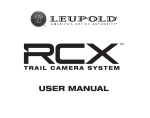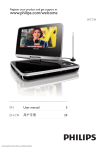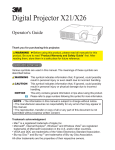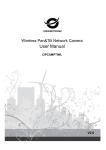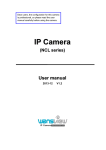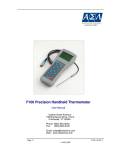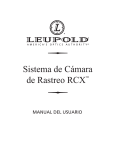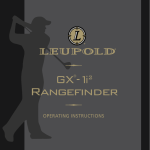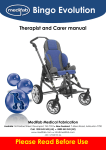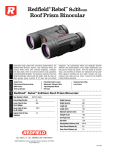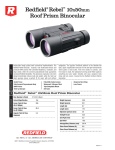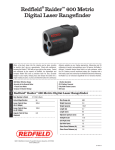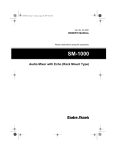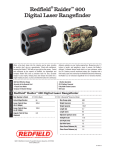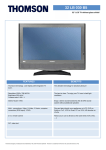Download USER MANUAL - Furrow Outdoors
Transcript
USER MANUAL Contents Introduction........................................................................................................... 3 Things you need to get started............................................................................. 4 Controller Setup.................................................................................................... 5 Camera Setup...................................................................................................... 10 Battery Guideline................................................................................................ 11 Camera Operation Setup..................................................................................... 12 Camera Setup with Preset Modes....................................................................... 13 DST (Dual Sensor Technology)............................................................................ 14 Camera Mounting............................................................................................... 15 Custom Camera Setup......................................................................................... 18 Using an External Power Source......................................................................... 21 Downloading Images..........................................................................................22 Troubleshooting.................................................................................................. 24 2 Introduction The RCX Trail Camera System is designed to support the use of many cameras and a single controller. The camera is simple, high quality and durable so you can place many cameras in the field, and quickly and easily access them to change setups, use Real Time Video Alignment and to download images. The system works by the camera capturing images and storing them on an SD card that you install. The controller also takes an SD card up to 32 GB. view the images right there in the field and make any changes to the setup you want. The controller also allows you to view photos from other trail cameras when the SD cards are inserted. The camera can be aligned using Real Time Video Alignment™ that permits you to see what the camera sees. Settings can also be changed to get more or less pictures by selecting one of 4 preset modes, or you may access the powerful custom menu for settings such as multipicture, event delay, time lapse, etc. See “Custom Camera Setup” on page 18 for more information. When you connect the controller to the camera with the USB cable, you can download images from the camera to the controller with just a couple of quick menu selections. You are then able 3 Things you need to get started 1. Camera 2. Controller (Included in RCX Kit. Li-Ion battery included.) 3. 8 AA Batteries (Leupold strongly recommends Energizer Ultimate Lithium AA batteries, especially for use in below freezing temperatures.)* 4. 2 SD or SDHC cards: one for the controller, one for the camera, up to 32 GB capacity. Accessories: 5. Mounting strap (Comes with camera or kit.) 6. USB Cable (Included with kits and with controllers.) 4 7. Standoffs (Included with cameras and kits. These are used to solidly position the camera on uneven surfaces.) Optional: RCX Lockdown Security Plate (Comes installed on RCX-2 only; for use with Master Lock® Python™ cable or for mounting with a single nail. Available separately for RCX-1.) *Alkaline batteries can leak and damage the camera if left unattended for extended periods, especially during below freezing temperatures. The RCX Trail Camera Warranty does not cover damage from battery leakage. Controller Set-Up Lanyard Hole Mini USB Port Cover Power Button Battery Door Battery Door Screw 3” TFT (Thin Film Transistor) Screen SD Card Slot Door 5 6 A controller must only be set once, but is necessary to set date and time, and to access the features of your RCX Camera. Every time a new camera is set up, the time synchronizes with the controller as soon as it is plugged in with the USB cable. The Lithium Ion battery is already installed in the controller. The controller battery should be charged for a minimum of 2 hours before use; however, it is preferable to charge it at least 16 hours to ensure long hours of use and to prevent short battery life. The first time the controller is powered up, the first screen presented is the “Time/Date” screen. To access this screen again later, you will find this selection in the “Setup Controller” Menu. This screen will again be the first screen presented any time you allow the battery to go dead for more than 24 hours. To charge the RCX Controller Battery, plug the Mini USB end of the USB cable into the controller, then plug the other end into a computer, the wall charger or the car charger provided. Before going into the field, verify that the controller is properly charged. Navigate through the controller menus by arrowing to the desired selection. On menu items with to the right of the text, press the right arrow to access the next level down in the menu . Press to select a menu choice. Delete and zoom are used only when viewing images on the SD card. Use to back out one menu level. 7 Brightness: The display brightness of the controller can be adjusted. This is recommended when lighting condition change dramatically. 6HWXS&RQWUROOHU %ULJKWQHVV 7LPH'DWH +HPLVSKHUH Time/Date: Time is in 24-hour time only. The default date format is YYYY/ DD/MM but can be changed to other formats. 1RUWKHUQ 7HPS8QLW /DQJXDJH (QJOLVK &RQWUROOHU9HUVLRQ )RUPDW6'&DUG Temp Unit: Switch between °F or °C. Hemisphere: Set the appropriate hemisphere. The United States and Canada are in the Northern Hemisphere. Australia, New Zealand and South Africa are in the Southern Hemisphere.. This makes the orientation of the moon phase images correct for your location. Language: The controller menus can be displayed in any of the following languages: English, German, Finnish, French, Italian, Russian, Spanish or Swedish. 8 BOTTOM ACCESS DOOR CLOSED Cover Retaining Screw 1/4-20 Tripod Stud Mount USB Port Cover 12V Jack Cover BOTTOM ACCESS DOOR OPEN Battery Pack 12V Jack Power Switch USB Port SD Card Slot Battery Pack Latch 9 6HWXS&DPHUD Camera Status 5&;&DPHUD,QIR 3RZHU6DYHU0RGH %UDG Camera Setup 1. Install an SD card. An SD card from another device may already contain files that will reduce the number of photos you can take. To optimize the operation of the camera’s SD card, format it using the controller. This can be done in the controller setup menu and by selecting “Format SD Card” from the bottom of the menu. This will erase all SD Card contents. Once the SD card is formatted, insert it into the camera. 10 2. Open the access door and remove the AA battery cartridge. 3. Insert 8 batteries with the negative (flat) end against the contact spring. 4. Insert the loaded battery cartridge into the camera with the contact side going in first until the catch snaps into place. Be sure to close the bottom door securely after all setup is complete to ensure good contact pressure. 5. Turn power on (“I” position). The camera won’t take pictures for 30 seconds after powered on or with the USB cable still connected to both the controller and the camera. freezing temperatures, and high power drain applications, regardless of what device they are used in. • Never mix battery types (Alkaline, Ni-MH, Lithium) or mAh rating. 6. Connect the controller to the camera with the USB cable. Allow several seconds for the controller to recognize the camera. When properly connected, the controller will show a camera status box at the bottom of the screen. • Never try to recharge a battery that is not labeled as rechargeable. Battery Guideline • Do not attempt to use only 4 batteries. 8 batteries are required for the RCX Cameras to function. • Ideally, use only Energizer® Ultimate Lithium AA batteries or the RCX Rechargeable Battery Pack, especially for cold weather use and night time photos & video. Alkaline batteries are adversely affected by • Use only the recommended charger for rechargeable batteries. • Always replace all batteries at the same time. • Follow the battery manufacturer’s recommendations for storage, handling and disposal. 11 Camera Operation Setup If you are using multiple RCX Cameras, it is recommended to give each camera a unique name the first time it is set up. This will name the folder where the photos are stored (which includes the camera name) for easy sorting after downloading from multiple cameras. Naming camera 1. With the camera powered on, connect the controller to the camera with the USB cable. 2. Select “Setup Camera”from the main menu. Press 3. Press until “Custom Setting” is highlighted. Press . 4. Press twice to move to “Page 2”, then Press to move to menu. 12 Press to select “Camera Name”, then press . 5. Select characters from the keyboard by using , and use to input the character. The name must be between 3 and 10 characters long. (Be sure the first 3 characters are unique between cameras to ensure all folders are easy to differentiate.) 6. Select “Save”and press . 7. Press . As you exit the custom settings, an“Update camera?” alert window appears. Press to upload the changes you made. This will be confirmed with the message “Camera Setup Complete”. Camera Setup with Preset Modes 1. Go to Camera Setup 2. Press 3. Select from the 4 preset modes the setting that is closest to what you want. Press . . RCX-2 Sensor (RCX-1 is 45° only) RCX-2 Flash (RCX-1 is 36 LED only) RCX- 1: 8MP RCX-2: 10MP OFF OFF DST 48 LED Auto Most Picture Mode 3MP 3 photos OFF DST 48 LED Super High Power Saver Mode (Day/Night) 3MP OFF 5 min DST 36 LED Auto Normal Video Mode 640x480, 30fps, 5 sec OFF 5 min DST 36 LED Auto For custom camera settings, see “Custom Camera Setup” on page 18. Sensitivity Event delay (time between photos) Best Picture Mode *DST only available with RCX-2 Image Quality Multipicture Automatically Selected Settings with Preset Modes 13 DST (Dual Sensor Technology) MAXIMUM TRIGGER RANGES 54° Camera Lens Angle 90ft 10° 45ft 45° 14 Dual Sensor Technology (DST ™) delivers a more complete picture of game activity in your area. Select the wider 45° sensor from “Custom Menu” with a range of 45 feet (ideal for larger areas) or select the narrower 10° sensor with a range of 90 feet (for use with a specific landmark or feeder). Both sensors can also be active at the same time by selecting DST. Only the RCX-2 features this ground-breaking technology. Camera Mounting Select a place to mount the camera (usually a tree). Avoid or remove any obstructions. 1. Locate the camera where sun does not shine directly into the camera for best exposure results. the most likely target movement is not coming straight toward the camera, since the PIR sensors work by comparing changes in temperature between 2 side-by-side elements. 2. Mount the camera at a distance above the ground at a height similar to that of the target and with the camera view parallel to the ground. This is especially important when using the 10° sensor alone. The sensor zone is a cone so if you angle it toward the ground, the sensor range may end on the ground short of where your targets will pass. The Lock-Down Security Plate attached to the RCX-2 is for use with a Master Lock® Python™ cable to prevent theft. A Lock-Down Security Plate for the RCX-1 is available and is sold separately from the unit. 3. It is best to set the camera up where 4. Run the strap through the slots. 5. Separate the buckle and thread the loose end of the strap through the loose buckle half. 6. Preadjust to a little larger than the 15 selected tree. 7. If the surface against the camera is very uneven, use the included standoffs to adjust the contact points on the back of the camera as needed. Three points of contact are best for stability and adjustment. Stack them for more height and fine-tune the final angle with the adjusting screw at the top of the camera after mounting. 8. Wrap the strap around the tree, and connect the buckle. Pull the straps just snug enough to keep the camera in place but to still allow the camera position to be adjusted. 9. Connect the controller to the camera with the USB cable. 10.Select the “Preview Camera” 16 Icon (the red deer) from the main menu to activate Real Time Video Alignment. You can now check the framing of your picture through the controller by seeing exactly where the camera is pointed. Think about how tall antlers might be and make sure to not cut them off at the top of the frame. Avoid framing too much sky in the picture as the exposure of the camera will compensate for this brightness and foreground images will be dark. This will also set the night time IR filter to the proper position to start taking photos. 11.Unplug the USB cable from the camera. You can verify that the camera is working properly by covering the light sensor, which is in the small hole above the Leupold medallion on the front left side the camera. Wave your hand in front of the camera and you’ll see the IR LEDs illuminate. A click of the IR filter moving into position for night pictures may also be heard. This movement typically occurs only twice per day: once in the morning and once at night. before securing the door and walking away. This uses the 30 second power buffer to allow time to get out of the camera’s sensor reach. The camera will not start taking photos until the USB cable is unplugged from the controller. NOTE: The camera has to have been powered up for 30 seconds before it will take pictures. This does include time during set up, so after alignment, it is usually ready to go. If you want to avoid taking pictures of yourself leaving the area, power the camera off and on 17 Custom Camera Setup Use the custom mode to refine settings. Night & day settings are modified seperately, so be sure to set them both. Automatic Camera Type Detection: The controller will automatically detect the type of camera and will only offer settings that are available with that model. If there is no camera connected, RCX-1 or RCX-2 can be chosen on the opening screen. Video/Picture: Select whether the camera will take video or still pictures. Resolution: .3MP* to 10 MP for RCX-2, .3MP* to 8 MP for RCX-1. 18 Video: 320x240* or 640x480 Video settings Video FPS: 15* or 30 Video frames per second determines how smoothly the video runs. The higher the number, the better the video, but the greater the file size. Video Length: 5* to 30 seconds *Lower values are recommended for smaller SD cards and for quick field downloads. Dual Sensor Technology (DST) Only the RCX-2 has DST, which uses both a 45° sensor and a 10° sensor. The 10° sensor provides the longest range and the 45° sensor provides a more forgiving wide sensor angle that nearly covers the 54° field of view of the camera. The camera can be setup to use either of the sensors or both in combination. Activate both when you want to maximize the number of pictures. The RCX-1 is equipped with only a 45° sensor Sensitivity Auto: Adjusts to higher sensitivity in hot weather when the air temperature is closer to that of a deer’s body. It automatically sets to lower sensitivity when it is cooler to avoid small target triggers, like birds and squirrels. Manual: Super high, high, medium and low. • Set to super high sensitivity for maximum picture count. 32GB SD cards and efficient power consumption can take more than 10,000 10MP images. While taking many pictures is possible, it will make field downloading slower. In instances where the SD card is nearly full, it may make more sense to change cards rather than to download. • Set to a lower setting if you are getting false triggers or pictures of animals farther away than you want. Operation Hours The camera can be set to run for a specific period of time to save batteries and to avoid triggers during periods 19 where there is a lot of activity that you don’t want to capture. For example, people and pets in your yard during the day when you are trying to capture night activity. The camera can be set to run during only daylight hours to avoid the power consumption of night pictures that require the IR LED flash. Night Pictures The camera automatically activates night mode when the light sensor tells it that there is not enough light for pictures without the IR flash. It will then activate the IR LEDs and take black and white night images. Set different night settings for your camera by selecting the night tab in the custom menu, and selecting settings to be applied during these night shots only. 20 For ease of operation, some settings cannot be customized separately for night shots. Time Lapse The Time Lapse feature allows the camera to automatically take a picture at intervals you select in the “input” menu. This allows movement to be captured beyond the trigger range. In addition, the very long intervals can be used for documenting changes like a plant growing, or the change of seasons. Time Lapse is great for food plots where there is constant activity and you don’t want to miss far targets or take multiple pictures of the same animal. Event Delay The Event Delay feature sets the camera to ignore triggers for a time after a picture is triggered. This is to avoid taking too many pictures of one animal. Tip: use with multipicture mode to snap a couple of pictures to make sure you get a good one, then wait for the next animal. Time Lapse and Event Delay cannot be used at the same time. Camera Name Enter a unique name for each camera. Your picture folder names will incorporate a part of the camera name. This will make organizing your picture files easier when you get home. (See “Download” section on page 22) Picture Stamp Set each piece of information to stamp on your picture individually: 1. Camera Name 2. Moon Phase 3. Date/Time 4. Barometric Pressure (RCX-2 only) 5. Temperature 6. File Name Using an External Power Source A cable for connecting an external 12V battery to a camera is included in the kits. A car or motorcycle battery can be used, provided that produces 12V and has external terminals that can be safely connected with the provided clamps. Insert the plug into the bottom of the camera by opening the rubber sealed 21 12V jack cover. Be sure to connect the red clamp to the positive (+) terminal and the black clamp to the negative (-) terminal. Downloading Images Camera to Controller Connect the controller to the camera with the USB cable. Select the “Download Images from Camera” icon and press . The next menu will show you two options: “Download” which downloads the photos and leaves them on the camera, or “Download and Delete” which downloads the photos and deletes them from the camera. Once one of the options is selected, press . The controller will begin 22 downloading and will show a count of how many pictures there are to download and the percent complete. If it appears downloading is going to take longer than you want to wait, open the bottom door and remove the SD card. Insert it into the controller for viewing and sorting the pictures, or change SD cards and wait until you get home to view pictures. Select the “View SD” icon to view pictures stored on the SD card installed in the controller. Controller to Computer Plug the USB into a computer and view the pictures taken on a computer screen. The controller acts as an external drive and allows you to move files from the controller to a computer in the same way. Viewing Images on a TV Plug the USB cable into a TV or any other device with a USB port that supports mass storage devices and use the TV controls to navigate through pictures to view them on the TV. Viewing Pictures on SD Cards from Other Cameras. The controller can be used to view any pictures in the field that are stored on an SD card using the industry standard DCIM file storage format. Simply insert the SD Card from another brand camera, and select select the “View SD” icon. 23 Troubleshooting The camera is not taking pictures or is only taking pictures some of the time. 1. Connect the controller to the camera and and look at the camera status window. This shows the camera’s battery status and SD capacity remaining. Replace batteries if needed. Empty, format, or replace SD card if needed. 2. If the custom mode was used to set up the camera, make sure you entered both day and night settings have been set for the menu items that allow this. 3. Ensure the hours of operation are set to 24hr. 4. Try a different SD card. A faulty SD card will cause either the controller or the camera to not function properly. See our web site for a list of approved SD card models. It is possible for an approved SD card model to fail. Try reformatting the SD card as well, using the controller setup menu. Format SD card is at the bottom of this menu. 5. Try new batteries. It is possible (though unlikely) for new batteries to be faulty. 24 The controller does not recognize the camera when the USB cable is plugged in. 1. Verify that the camera is powered on. “I” is the “On” position of the switch. 2. If the batteries are not fresh, replace the batteries. 3. Verify that all batteries are installed in the correct orientation. The flat, negative end of the batteries should all be placed against the coil spring side in the battery cartridge. 4. Verify that all batteries are of the same type. 5. Be sure the battery cartridge is completely installed and the latch is snapped into place. The bottom door should be securely closed to ensure good contact. My pictures are foggy. 1. Check to make sure the sun is not shining directly into the camera lens. Realign as needed. 2. At about the same time of day when the foggy pictures are occurring, connect the controller to the camera and select the “View Camera” icon to activate Real Time Video Alignment. 25 3. Check the camera lens window to see if it is dirty. Clean if needed with a soft cloth or a cotton swab with alcohol or lens cleaning fluid applied. DO NOT USE ACETONE OR ANY OTHER SOLVENT. DOING SO WILL DAMAGE THE VIEWING WINDOW AND VOID YOUR WARRANTY. My pictures are black & white and overexposed. 1. Check the light sensor to and make sure it is unobstructed. The light sensor is located on the front of the camera, on the left side, just above the Leupold medallion. If it is obstructed, the camera will set itself to always take night pictures. My camera is taking the correct type of pictures in day or night only but not both? 1. Verify that you entered both day and night settings for the menu items that allow this. 26 My flash range is getting shorter over time. 1. The RCX Camera System is designed to reduce IR LED power when the batteries get low in order to extend the life of the batteries. To restore a longer flash range, install fresh batteries. My camera is not taking night pictures or videos. 1. Use Energizer Ultimate Lithium batteries or an external power source when taking night video or when using the 48 LED setting in the RCX-2. 2. When batteries get very low, The RCX Trail Camera is designed to take only day pictures in order to extend the useful life of the batteries. Replace the batteries to restore full functionality. 27 One Year Limited Warranty Leupold RCX Trail Camera is warranted by the Leupold Electronics Warranty, and are protected from defects in materials and workmanship for ONE YEAR from the date of purchase. The warranty is void if damage results from unauthorized repair, alteration, misuse, or battery leakage. The warranty is given solely to the original owner and is not transferable. Leupold & Stevens, Inc. requires that after 30 days of purchase, any customer returns of RCX Trail Cameras or Camera Components (other than those still in sealed factory packaging) be sent directly to Leupold & Stevens, Inc. for warranty inspection and evaluation. For warranty service please contact Technical Services first at 1-800 LEUPOLD. When instructed to do so, send your product to: Leupold & Stevens, Inc. ATTN: Product Service 14400 NW Greenbrier Parkway Beaverton, OR 97006 28 29 30 31 Leupold & Stevens, Inc. 1-800-LEUPOLD » 1-503-646-9171 » www.leupold.com PO Box 688, Beaverton, OR 97075-0688 14400 NW Greenbrier Parkway, Beaverton, OR 97006-5790 USA Part# 112161 Artwork#112163
































